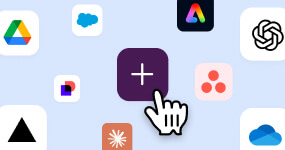About Engine
Engine transforms the way companies book and manage business travel
Founded to modernize a historically complex industry, Engine has quickly become a leader in travel technology, recently reaching a $2.1 billion valuation. The platform powers mobile-first booking, automated approvals, and fraud detection, providing a faster, smarter way to manage business travel at scale. The result: smoother trips for travelers and fewer headaches for companies.
The challenge
Hypergrowth brought complexity, straining Engine’s ability to grow without slowing down
After doubling its valuation, Engine faced rising pressure: more than 500,000 customer inquiries per year, teams scaling across a hybrid workforce, and operational sprawl across 100+ tools including Salesforce, Asana, Google Workspace, Confluence, and Jira Help Desk. Speed was no longer enough.
Teams needed clarity and efficiency across employees and customers, without relying on constant headcount growth.
“Our service standard is speed and quality. Agentforce gives us both, with a level of personalization no chatbot can match.”
How Engine works better with Slack
Slack connects Engine’s people, apps, and AI agents to scale and accelerate work
Slack is where Engine’s communication, applications, and operations converge. With single sign-on and more than 100 integrated tools, employees work directly in Slack without switching tabs.
“Slack is the hub for everything we do,” said Mollie Bodensteiner, SVP of Operations. “It’s where I start my day, where I communicate, manage tasks, and collaborate across the business.”
Slack also keeps Engine’s hybrid workforce aligned. Structured channels reduce noise and make it easier for teams to stay focused, while automations streamline routine work and keep projects moving forward. And with Slack Connect, Engine collaborates directly with vendors and partners without the delays of email.
Scaling with AI agents in Slack
To handle surging customer demand, Engine deployed Eva (Engine’s virtual assistant), a customer-facing AI agent built on Agentforce. Eva resolves bookings and reservation modifications end-to-end by pulling data from Service Cloud and Engine’s booking platform.
“Agentforce saves hours of manual work and lets our team focus on higher-value problems,” said Chief of Staff John Siladie.
Building on Eva’s success, Engine introduced Mae (Multi-purpose admin expert), an employee-facing AI agent inside Slack. Mae acts as a central hub for employee engagement questions spanning IT, HR, product, and accounting. It cascades requests to the right specialized agent behind the scenes, so employees never have to guess where to go. They stay in one seamless conversation even as topics shift.
“Mae reduces repetitive questions, cuts ticket volume, and gives managers back valuable time,” said Bodensteiner.
Engine also deployed Cloe (Client operations expert) to strengthen client-facing processes in Slack. Before, dissatisfied CSAT survey scores routed into Slack channels for manager review. Fraud alerts also streamed into a dedicated Slack channel, where specialists claimed ownership with 👀 emoji and tracked outcomes with ✅ / ❌ reactions that fed audits in Google Sheets.
Cloe enhances these workflows by autonomously triaging, summarizing, and pre-filling escalation tickets, allowing client operations specialists to dedicate their expertise to the most complex and high-stakes cases.
And with a move to Slack’s highest-tier plan, Engine unlocked AI in Slack, enabling daily recaps, file summaries, and enterprise search across Slack, Salesforce, Confluence, and beyond. “AI in Slack is our internal unlock,” said Siladie. “It enables our people to get answers instantly and keep moving.”
“Slack has become my first stop when I'm looking for knowledge or information. With AI in Slack and enterprise search, it’s even more powerful and surfaces answers faster.”
Next steps
Engine envisions a digital workforce where every employee has a personalized AI agent inside Slack
Backed by Salesforce’s unified platform, including Sales Cloud, Service Cloud, Data Cloud, and the Einstein Trust Layer, Engine continues to expand its AI-powered workforce. Future development includes enabling Mae to autonomously take actions like triggering approvals or creating Jira tickets, and expanding Cloe to handle more critical client operations workflows.
Engine’s long-term goal is to give every employee their own AI assistant inside Slack, with agents like Mae and Cloe that understand their role, connect to the right systems, and take action. The vision is a single, intuitive interface that brings these agents together, so employees don’t have to jump between tools or websites to get work done.
“We’re building for scale, not just speed,” said Bodensteiner. “Slack and Salesforce give us the structure to automate the work that slows people down and the flexibility to keep innovating as we grow.”















